गोभी तितलियों की पारिस्थितिकी के अनुकूल प्रबंधन: भारत के पहाड़ी क्षेत्रों में कोल फसलों के सबसे विनाशकारी कीट
Plants belonging to the genus Brassica (more specifically, varieties of the species Brassica oleracea) within the family Brassicaceaeor Cruciferae are referred as Cole Crops. Due to its high nutritional value, these crops (viz., cabbage, cauliflower, knolkhol, brocolii, toria, sarson and mustard etc.) are extensively grown in various parts of the world. It provides much needed dietary fibres, essential minerals and vitamins. Cole crops are also the major component of human diet throughout the world. It has been estimated that insect pest alone causes more than 40% of yield loss of vegetables annually.
Among all, the large white cabbage butterfly, Pieris brassicae and small white cabbage butterfly, Pieris repae (Pieridae: Lepidoptera) are the most destructive pests of cruciferous crops across the World, and often cause heavy losses in yield. It causes extensive damage in almost all parts of India, during seedling, vegetative and flowering stages of cole crops. During winter this pest survived in the plains and migrates to hilly regions during summer in India. Furthermore, they are highly fecund and voracious feeder and therefore make insecticidal applications necessary for cultivation of cruciferous crops. Besides higher cost, these insecticides cause undesirable side effects to the human health and thus, biological control are now gaining importance day by day.
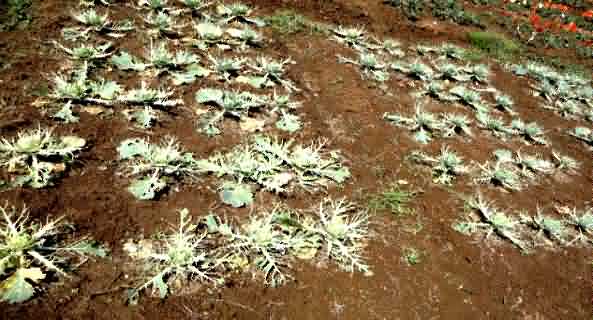
Figure 1. Cabbage crop completely damaged by P. brassicae
Biology and nature of damage:
The caterpillars alone cause damage. The first instar caterpillars just scrap the leaf surface, whereas the subsequent instars consume up leaves from the margins inwards, leaving intact the main veins (Figure 1). Often, entire plants are eaten up. This is by far the most destructive pest on cole crops in hilly region of India
Female lays around 170 eggs in clusters of 60-90 on leaf surface. Egg period 7-12 days, larval period 15-23 days, pupal period lasts for 8-12 days; adult longevity is up to 13 days. Larvae, in its initial instars, pale yellow and turns greenish-yellow later on; fully grown larvae with black head, short hairs on body and dorsum with black spots. Adult butterfly creamy white with forewing apically black tipped two large black spot ventrally; female with dorsal black spot also; hind wing with large apical black spot (Figure 2).
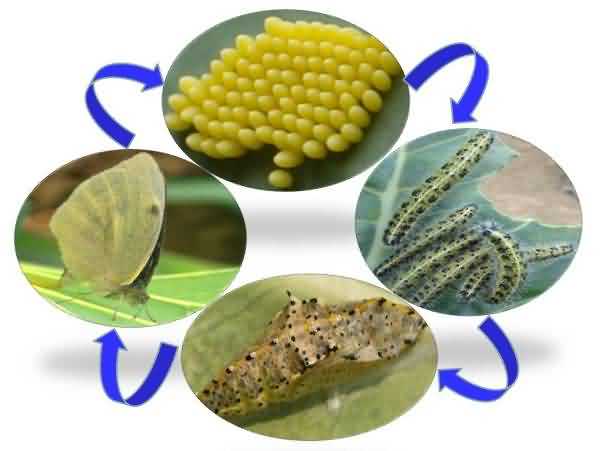
Figure 2. Life cycle of cabbage butterfly, P. brassicae
Natural enemies of cabbage butterflies:
Cruciferous ecosystems harbor several potential natural enemies in India (Figure 3) viz. egg parasitoid, Trichogramma brassicae, larval parasitoids, Hyposoter ebeninus, Cotesia glomerata, Exorista larvarum, Exorista bombysis and pupal parasitoids, Pteromalus puparum, Brachymeria femorata, Brachymeria spp., etc. Natural parasitism of P. brassicae in few localities of India is found to be from 20 to 80%.Therefore, we have tremendous scope for their utilization under field conditions.
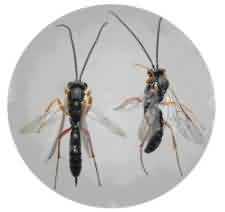
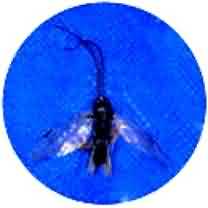
Adult female (left) and male(right) , Cotesia glomerata adult of Hyposoter ebeninus
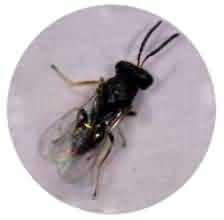
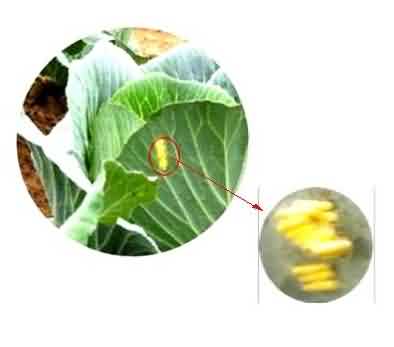
Pteromalus puparum adult , Cotesia glomerata cocoons
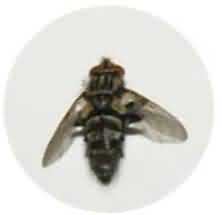
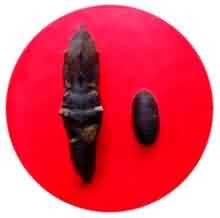
Exorista bombycis , Cocoon of E. bombycis outside P.brassicae pupa
Figure 3. Natural enemies of cabbage butterfly
Eco-friendly management of cabbage butterflies:
Cultural control:
Early transplanted (early September) cole crops suffer less infestation of cabbage butterflies than late (late January) transplanted crops
Mechanical:
Hand picking and destruction of Pieris brassicae eggs and larvae reduce the pest multiplication.
Biological control:
Conservation of bio-controling agents, by providing floral sources nearby cabbage fields. Place plastic cups containing cotton swabbed with 50% honey solution and keep such cups @ 1cup/100m2 encourage parasitism by natural enemies.
Spraying withLipel 8 SP (Bt var. Kurstaki) @ 0.2% at 15 days interval after 22-25 DAT of crop controls cabbage butterfly larvae effectively.
Spraying withAnonin or Derisom @ 2ml/litre of water at 15 days interval after 22-25 DAT of crop controls cabbage butterfly larvae effectively
Chemical control
Two sprayings of fenvalerate (0.1%) or deltamethrin (0.003%) at 15 days interval after 22-25 DAT manage the cabbage butterfly larvae and aphids. About 250 to 400 litres spray fluid is required for one hectare of crop.
Authors:
D. M. Firake and G T Behere
Division of Crop Improvement (Entomology)
ICAR Research Complex for NEH region,
Umiam, Meghalaya (India)
